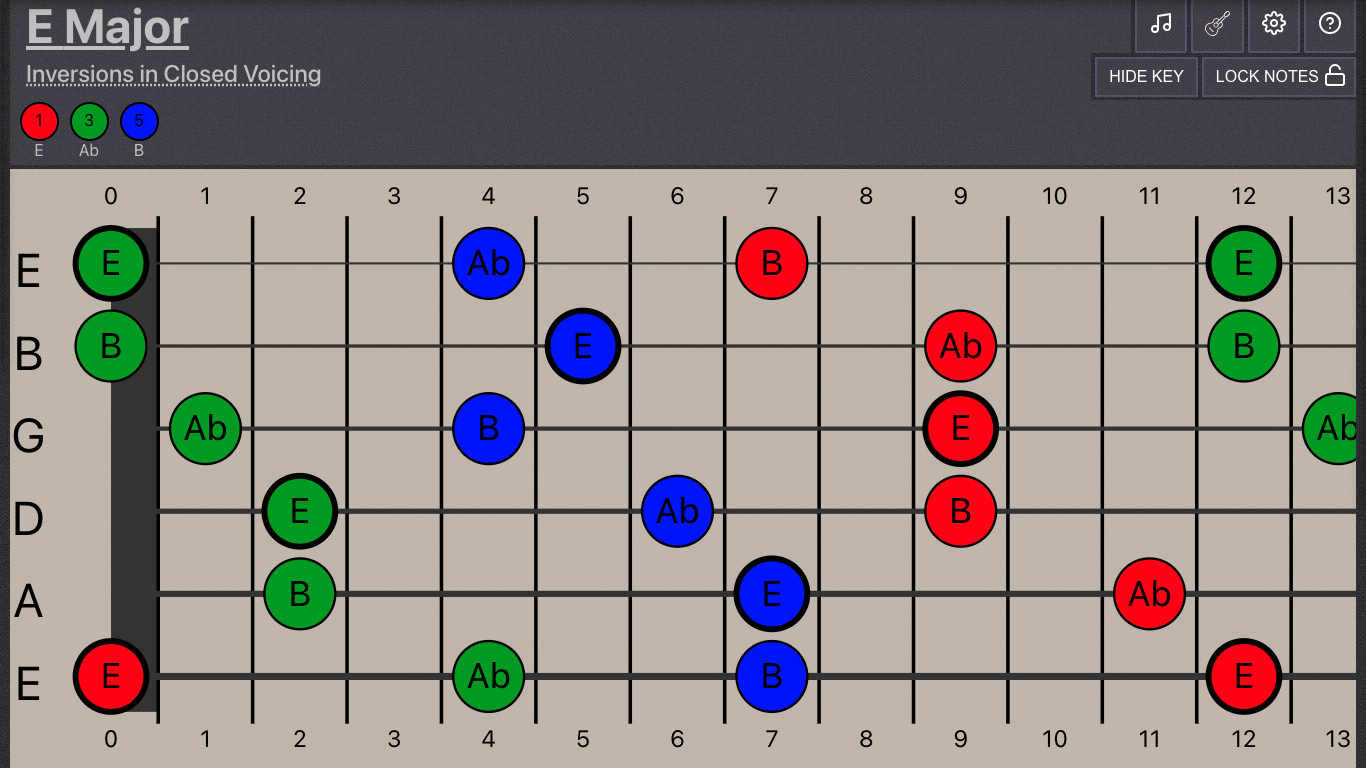In this post we will examine how we can learn from close voicing moving across adjacent strings. The previous two posts, Alternate Picking Using Three-Note Triads In Closed Voicing Along The Strings and Fingerstyle Picking Using Four-Note Triads In Closed Voicing Along The String, have focussed on moving between the inversions of a chord along the length of each string. Both posts explain using rhythmic motifs and a specific string plucking technique to create an almost symbiotic process. These exercises help to develop fretting and picking technique alongside note retention, harmony, and rhythm.
Moving along the strings is arguably one of the more intuitive aspects of instruments with a fretboard. The smaller the length of the physically vibrating string section between the finger and bridge, the higher the pitch of the sound of the produced note. The further up the fretboard, the higher the pitch sounds. Moving between adjacent strings is not quite as intuitive.
Moving Between Adjacent Strings
A critical aspect of technique that neither article discussed is moving between different strings. In the context of single-note scales or arpeggios, there are various methodologies and strategies for grouping notes. Often described as “patterns”, “boxes” or “positions” and “shapes”. You can find a discussion on this here (coming soon..).
It is perhaps less clear how to traverse the fretboard across adjacent strings in a harmonic context, when there are many notes creating a chord. Occasionally, there is more than one note of the same type, for example, two notes of G on different strings. On the guitar, these occurrences are relatively common. For example, the famous, “power chord” or “Five chords” or just G5 regularly contain two notes of G, at two different pitches. Many frequently used Open & Barre position chords have irregular type of voicing with doubled or even tripled notes of the same note name. It’s very challenging if not impossible for most people to implement their relative inversions, using Fretharmony, try to align the colours of an open position E Major chord or see the picture below.

Complicating things further is that different tuning systems alter the order between adjacent strings. For example on guitar tuned to Drop D, a power chord can be played with a single finger barring the lowest three strings.
Applying Close Voicing To Order Adjacent Strings
Close-voicing provides a great opportunity to learn how to methodically move through a chords inversions between adjacent string sets as opposed to along the string. It is particularly effective in the case of chords containing only three different kinds of note. Furthermore, not only does the exercise provide a logical harmonic pathway for traversing the fretboard it also focusses on a different kind of fretting dexterity and motion.
For example, in the video below I explain how certain fretting fingers can remain planted between different inversions and that there are often multiple fretting options, which furthers fretboard intuition and awareness of the technical options. You can also find more here, moving three note chords across the strings.
Fretharmony Master Mode
A useful feature that Fretharmony provides is the option to show a “Master“ voicing for triad chords. Master voicing can be activated by choosing Close voicing and selecting Master from the StringSet options menu.
Applying A Rhythmic Motif And Picking Technique
As the previous articles explained the concepts in more detail. Rather than list all the exercises again Let’s examine what two examples look like on tablature and sheet music.
Alternate Picking An E Major In Close Voicing
In the example below the tablature indicates that the player should follow an alternating picking pattern starting with a downstroke.
Fingerstyle Picking An E Major In Close Voicing
The tablature and sheet music below shows a PIMA picking pattern.
Close Voicing Moving Across Adjacent Strings – Final Thoughts
The concepts discussed throughout this current post, Alternate Picking Using Three-Note Triads In Closed Voicing Along The Strings and Fingerstyle Picking Using Four-Note Triads In Closed Voicing Along The String, can be combined together. Evidentally, this provides a new area of potential discovery, opportunities and choices using a technical patterns and rhythmic motifs.




